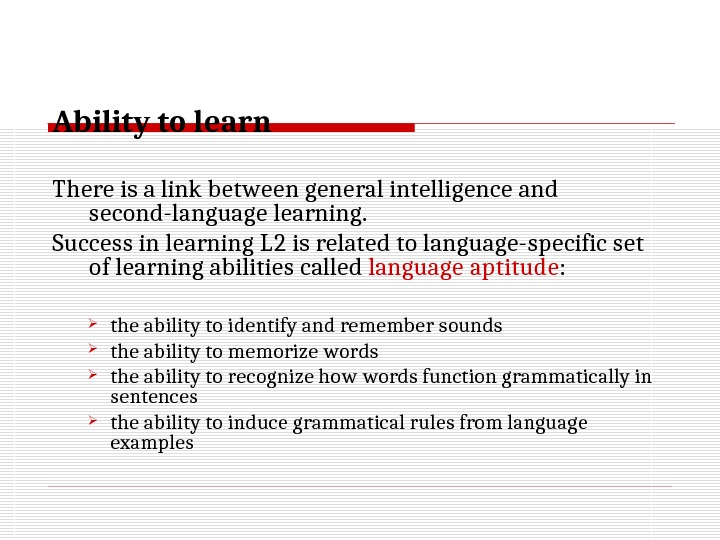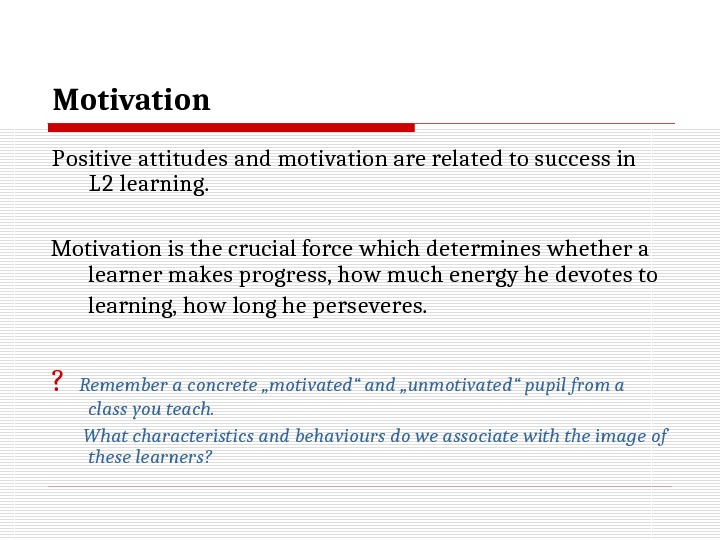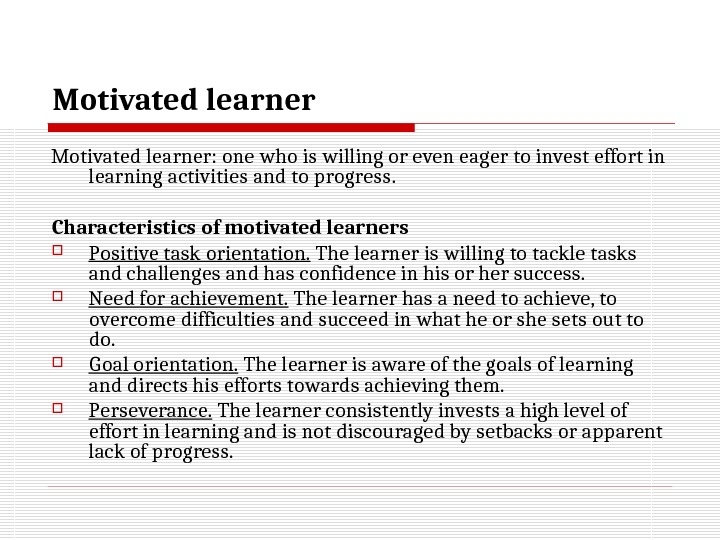Differences between learners What affects the success











differences_between_learners.ppt
- Размер: 69.5 Кб
- Количество слайдов: 11
Описание презентации Differences between learners What affects the success по слайдам
 Differences between learners
Differences between learners
 What affects the success in learning a FL? the metho ds and materials the teacher’s qualities and personality the learning conditions (e. g. age, t ime , learning outside school, opportunities for authentic contact with L 2) the personality of the pupil tolerance of ambiguity a high capacity for empathy willingness to take risks a high level of self-esteem a low level inhibition Overall, l anguage aptitude and motivation are the two most influential factors in terms of success in learning a FL.
What affects the success in learning a FL? the metho ds and materials the teacher’s qualities and personality the learning conditions (e. g. age, t ime , learning outside school, opportunities for authentic contact with L 2) the personality of the pupil tolerance of ambiguity a high capacity for empathy willingness to take risks a high level of self-esteem a low level inhibition Overall, l anguage aptitude and motivation are the two most influential factors in terms of success in learning a FL.
 Ability to learn There is a link between general intelligence and second-language learning. Success in learning L 2 is related to language-specific set of learning abilitie s called language aptitude : the ability to identify and remember sounds the ability to memorize words the ability to recognize how words function grammatically in sentences the ability to induce grammatical rules from language examples
Ability to learn There is a link between general intelligence and second-language learning. Success in learning L 2 is related to language-specific set of learning abilitie s called language aptitude : the ability to identify and remember sounds the ability to memorize words the ability to recognize how words function grammatically in sentences the ability to induce grammatical rules from language examples
 Motivation P ositive attitudes and motivation are related to success in L 2 learning. M otivation is the crucial force which determines whether a learner makes progress, how much energy he devotes to learning, how long he perseveres. ? Remember a concrete „motivated“ and „unmotivated“ pupil from a class you teach. What characteristics and behaviours do we associate with the image of these learners?
Motivation P ositive attitudes and motivation are related to success in L 2 learning. M otivation is the crucial force which determines whether a learner makes progress, how much energy he devotes to learning, how long he perseveres. ? Remember a concrete „motivated“ and „unmotivated“ pupil from a class you teach. What characteristics and behaviours do we associate with the image of these learners?
 Motivated learner M otivated learner: one who is willing or even eager to invest effort in learning activities and to progress. Characteristics of motivated learners Positive task orientation. The learner is willing to tackle tasks and challenges and has confidence in his or her success. Need for achievement. The learner has a need to achieve, to overcome difficulties and succeed in what he or she sets out to do. Goal orientation. The learner is aware of the goals of learning and directs his efforts towards achieving them. Perseverance. The learner consistently invests a high level of effort in learning and is not discouraged by setbacks or apparent lack of progress.
Motivated learner M otivated learner: one who is willing or even eager to invest effort in learning activities and to progress. Characteristics of motivated learners Positive task orientation. The learner is willing to tackle tasks and challenges and has confidence in his or her success. Need for achievement. The learner has a need to achieve, to overcome difficulties and succeed in what he or she sets out to do. Goal orientation. The learner is aware of the goals of learning and directs his efforts towards achieving them. Perseverance. The learner consistently invests a high level of effort in learning and is not discouraged by setbacks or apparent lack of progress.
 Types of motivation I ntegrative A learner with integrative motivation has a genuine interest in the second language community. He wants to learn the language in order to communicat e and to gain closer contact with t he people and their culture. I nstrumental A learner with instrumental motivation is more interested in how the second language can be a useful instrument towards furthering other goals, such as gaining a necessary qualification or improvin g employment prospects. ? Can you apply this classification to your own motivation for learning a foreign language?
Types of motivation I ntegrative A learner with integrative motivation has a genuine interest in the second language community. He wants to learn the language in order to communicat e and to gain closer contact with t he people and their culture. I nstrumental A learner with instrumental motivation is more interested in how the second language can be a useful instrument towards furthering other goals, such as gaining a necessary qualification or improvin g employment prospects. ? Can you apply this classification to your own motivation for learning a foreign language?
 Types of motivation Extrinsic — derived from external incentives , can be affected to a certain extent Intrinsic — the urge to engage in the learning activity for its own sake — typical of young c hildren, tends to deteriorate with age — largely rooted in the previous attitudes of the learner s
Types of motivation Extrinsic — derived from external incentives , can be affected to a certain extent Intrinsic — the urge to engage in the learning activity for its own sake — typical of young c hildren, tends to deteriorate with age — largely rooted in the previous attitudes of the learner s
 Ways of affecting extrinsic motivation Some aspects cannot be affected, e. g. peer-group influences, the wish to succeed in an exam. Teachers can work with success and failure : S uccess — l earners who have succeeded in past tasks will be more willing to engage with the next one, more confident and more likely to persevere — teacher s should also recognize the investment of effort and care ? In what ways do you inform your pupils of their success?
Ways of affecting extrinsic motivation Some aspects cannot be affected, e. g. peer-group influences, the wish to succeed in an exam. Teachers can work with success and failure : S uccess — l earners who have succeeded in past tasks will be more willing to engage with the next one, more confident and more likely to persevere — teacher s should also recognize the investment of effort and care ? In what ways do you inform your pupils of their success?
 Ways of affecting extrinsic motivation Failure — learners should be aware that they are failing if they have done significantly less than they could have — too much anxiety hinders learning, a certain amount can stimulate a learner to invest more energy in the task – so called facilitative anxiety (just enough tension to get the job done, slight feeling of nervousness)
Ways of affecting extrinsic motivation Failure — learners should be aware that they are failing if they have done significantly less than they could have — too much anxiety hinders learning, a certain amount can stimulate a learner to invest more energy in the task – so called facilitative anxiety (just enough tension to get the job done, slight feeling of nervousness)
 How to c reat e interest in lesson s and learning English: — clear goals (both short and long term) — varied and meaningful topics and tasks — contact with authentic L 2 situations (native speakers, a trip to the UK, Internet…) — appealing materials (visuals , booklets, realia… ) — fun activities (games, jokes, stories, songs, video clips…) — personalisation (tasks that have to do with the learners ’ opinions, experiences, ideas; teacher must show interest in these, be open, accepting and encouraging) — needs analysis (find out and take into consideration)
How to c reat e interest in lesson s and learning English: — clear goals (both short and long term) — varied and meaningful topics and tasks — contact with authentic L 2 situations (native speakers, a trip to the UK, Internet…) — appealing materials (visuals , booklets, realia… ) — fun activities (games, jokes, stories, songs, video clips…) — personalisation (tasks that have to do with the learners ’ opinions, experiences, ideas; teacher must show interest in these, be open, accepting and encouraging) — needs analysis (find out and take into consideration)
 The top motivating techniques What technique or activity has proved to be highly motivating for teenage English learners? —
The top motivating techniques What technique or activity has proved to be highly motivating for teenage English learners? —
